CDC reports Americans are having fewer children now than in decades: Experts posit two main culprits
>
Just over half of women under the age of 45 are having babies in the US, according to official data highlighting the country’s fertility drought.
From 2002 to 2019, the proportion of women aged 15-45 with at least one child dropped from 59.9% to 52.1%, a drop of one eighth.
The number dropped from 46.7 percent to 39.7 percent among men in the same time, according to the Centers for Disease Control and Prevention (CDC) national survey.
The overall birth rate fell 13 percent between 2002 and 2019, from 13.9 births per 1,000 people to 12.
The results highlight the staggeringly low birth rate in the United States, which some experts fear could cause a crisis for decades to come. However, the most recent data emerging from the pandemic shows that the birth rate may now be rising as a positive sign.
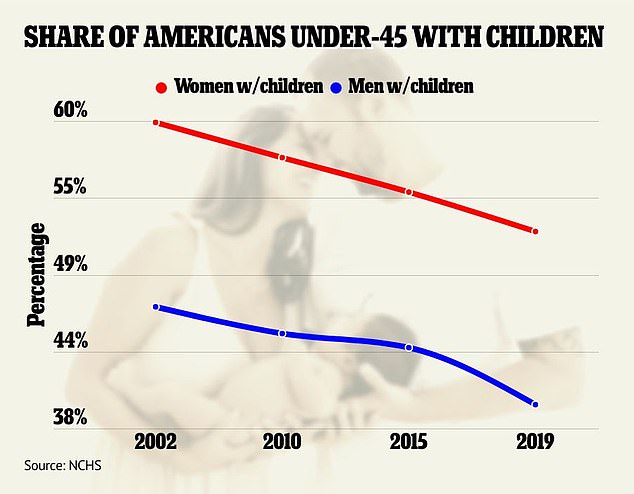
The number of American women with at least one child dropped to just 52.1%, while the number of men dropped to 39.7% in 2019.
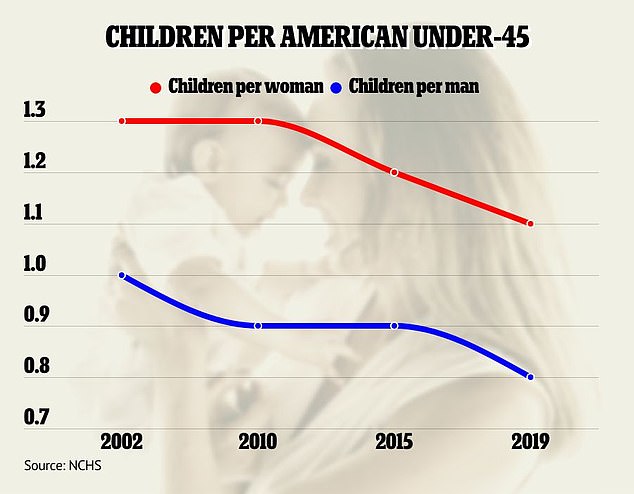

The average American woman under 45 has 1.1 children, while the average man has 0.8, reports the CDC
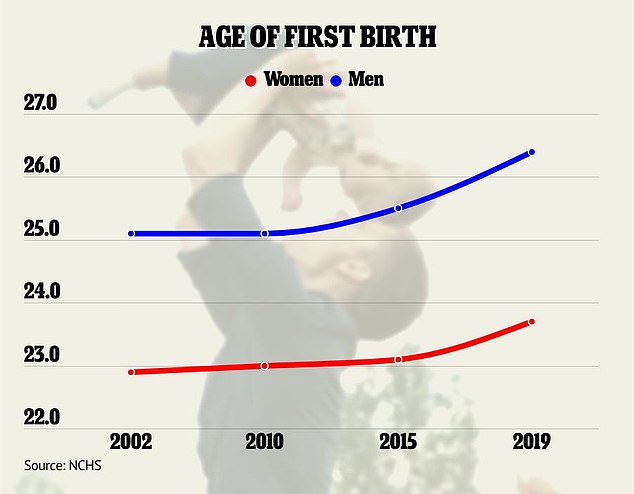

Men now have their first child at 26.4 years on average, while women give birth for the first time at 23.7. Both have increased considerably in the last two decades.
Many experts have warned that the US will suffer a shortage of workers in the next half century as a result of the declining birth rate.
It is feared that it will lead to economic stagnation and leave public services unable to serve the elderly population without a strong base of younger taxpayers to support them.
The increasing age of women in the US and declining birth rates have been attributed to women putting off having children until later in life to pursue careers, as well as advances in IVF and other fertility treatments.
The CDC also highlighted the rising costs of becoming a parent, with estimates suggesting it costs more than $300,000 to raise a child to age 18.
These rising costs are part of the reason many have delayed starting a family in recent decades.
Women are having their first child when they are 0.8 years older than in 2002, with an average age that has risen from 22.9 to 23.7 years.
Men have always had their first child at an older age than women, but have experienced a similar increase in age when they become parents for the first time: from 25.1 to 26.4 years.
These numbers do not take into account the Covid pandemic, which likely caused the average age to rise as teen pregnancies fell along with a general drop in fertility.
In recently published research, the National Center for Health Statistics (NCHS), a branch of the CDC, reports 3.7 million US births in 2019, a slight decrease from the previous year.
Over a five-year period, the researchers surveyed 21,441 men and women ages 44 and younger across the United States to collect data on births and fertility.
They found that women were more likely to have children than men, were more likely to become parents at a younger age, and report more children on average.
The researchers found that 52.1 percent of the women had at least one child.
This is a drop from 54.9 percent in 2015, the most recent previous version of the survey, and a massive drop from nearly 60 percent of women under 45 who gave birth in 2002.
The drop was even more drastic among men. Just under 47 percent reported being a father in 2002, but the number dropped below 40 percent in 2019.
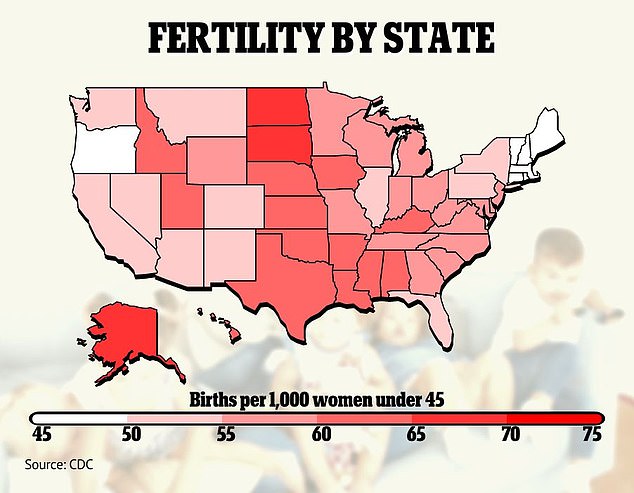

North Dakota, South Dakota, and Alaska are the most fertile states in the United States, with more than 65 annual births per 1,000 women of childbearing age.
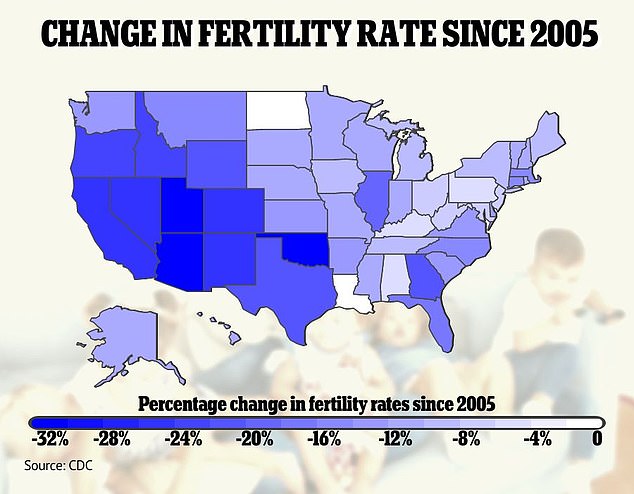

Fertility rates fell the most since 2005 in Utah, Arizona, Colorado, Nevada and California
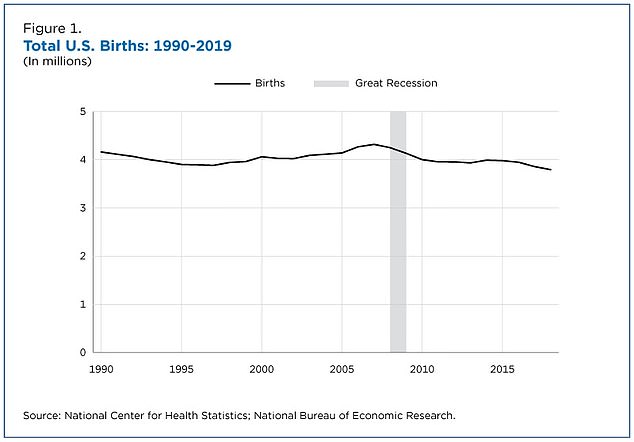

The overall birth rate in the United States has been declining in recent decades, and the US Census highlights the 2008 recession as a turning point in the decline in fertility in the United States.
An average American woman under the age of 45 has 1.1 children, up from 1.3 in 2002. Men fell below the mark of one per member of the population in 2010, falling from 1.0 to 0.9. In 2019, the average man had 0.8 children.
While Americans are having fewer children now than they were two decades ago, they are also having children later than in years past.
While fertility rates have been declining almost across the board in the US, some states have experienced it significantly more than others.
In Arizona, the number of births per 1,000 women under age 45 in the state dropped from 80.6 in 2005 to 54 in 2020, a 33 percent drop in 15 years.
Utah, once the most fertile state in the United States, has seen its fertility rate drop by 31 percent, from 92.8 births per 1,000 women under age 45 to 64.1.
Other states like Colorado (26 percent drop in birth rate), Nevada (26 percent), California (26 percent) and New Mexico (25 percent) were also among those with the steepest drop.
North Dakota was the only state where the birth rate increased, growing four percent from 64.8 to 67.4 over the 15-year period. Louisiana did not experience any change in its birth rate.
While a host of factors can cause this decline, experts have pointed to two main culprits.
First, women are a larger part of the workforce now than in the past.
They are more likely to graduate from high school or college than their male peers and to achieve higher levels in their respective careers as a result.
In turn, many women have put off having a child when they were younger and have instead focused on their work.
There are also economic factors at play. The US Census Bureau points to the 2008 recession as a trigger for declining birth rates in the United States.
The recession caused many families to lose a large chunk of their savings and job losses in all industries, making it difficult for many families to bring up another child.
As more Americans attend college and education costs rise, so has the proportion of the 20-year-old population carrying thousands of dollars in debt.
Many may push building a family until they are at a more secure point in life, and for some Americans that may never come.
The use of contraceptives such as condoms, birth control, and other family planning methods are also more common now than in years past.
